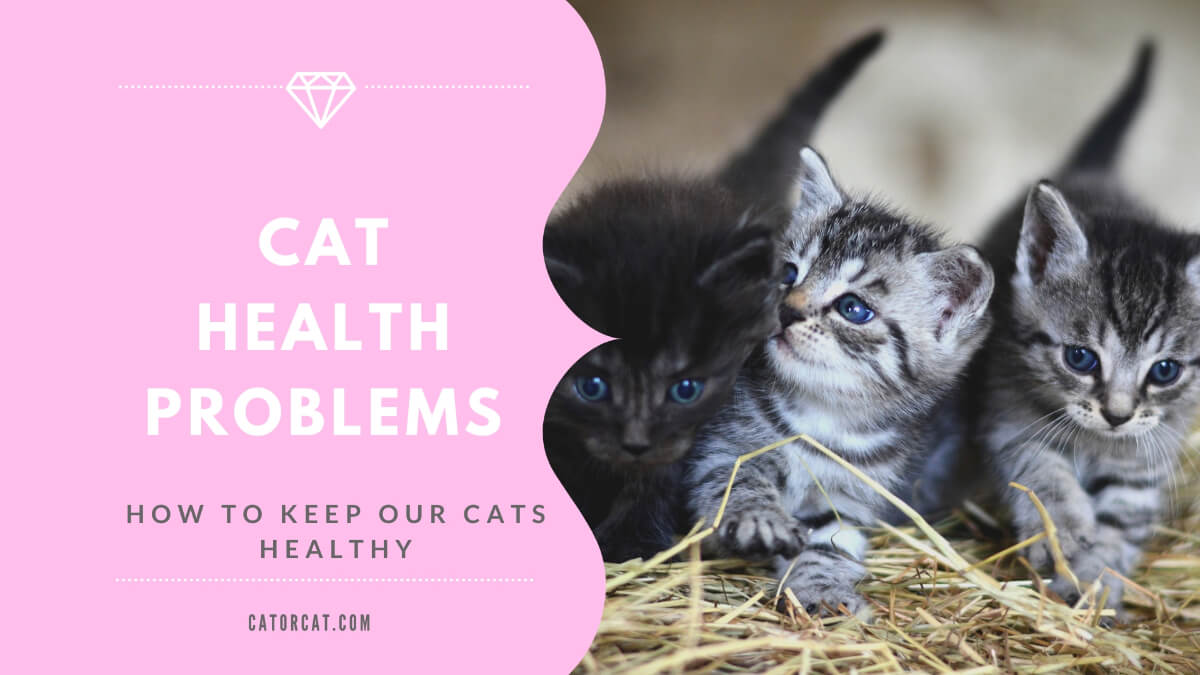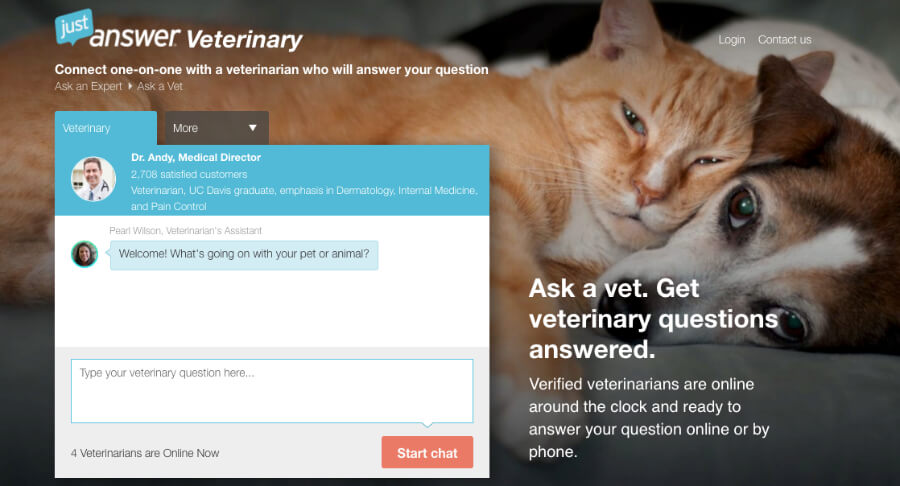
If you are like me, you love your cat and treat him or her as one of the family. One thing cats have in common with us is they have health issues and they get sick too. Cat health problems and issues are often the same ones as humans.
If you are wondering how to know if a cat is sick, there are some things you can look for. It’s important to be observant of changes, especially as the cat is getting older.
Of course, when it comes to diagnosing disease in cats, only your vet can make that determination. There are signs you can watch for which might indicate an illness. Sometimes it will be obvious, but other times it may be gradual and over time. Cats are independent animals and even if something is wrong they may hide it for a while.
I hope this article will be helpful to you, I’ve been a cat owner for many years, and have experience dealing with quite a few cat health problems.
Most common health problems in cats and treatment options
1. Cat is sneezing, rubbing face, or itching
Cats can have the same health problems people do, including allergies. If your cat is rubbing his or her face or itching or has runny eyes or nose, it may be from allergies. Then it’s a matter of finding out what the cat is reacting to. The cat could be sensitive to pollen or other airborne things, or it could be from their food, insects, or other causes. It may take some trial and error to determine what your pet is allergic to. Sometimes the cause can be fairly easy to figure out. If you have recently changed your cat’s diet, that could be the cause. Otherwise, you might try removing something from the environment you think could be triggering the symptoms. It could even be certain household cleaners or laundry detergent. If the problem is difficult to solve your vet can give you antihistamines (or buy it online). Medication may have to be a last resort, if it’s an airborne problem such as pollen there isn’t much else you can do.
2. Cat is eating or drinking excessively
Normally a cat does not eat or drink more than they need unless there is a good reason for it.
Drinking a lot of water can be an indication that the cat has chronic kidney failure. This is particularly something to watch for as the cat ages. If your cat is showing this behavior it’s best to take them to a vet to check her for kidney disease. On the other hand, if the cat refuses to eat or drink it’s important he or she sees a vet quickly. Cats will get dehydrated in a short time, and their usual instinct is to drink and drink when they are hungry or thirsty, so they will need help right away. If your cat drinks out of the toilet bowl, it may be because he or she likes the cold water. The cat’s water dish should be changed often so the water is fresh. The easiest way to avoid this problem is to keep the toilet seat down or keep the bathroom door closed.
Related: Best Cat Water Fountain
3. Cat urinating outside the litter box
If your cat is urinating outside the litter box, it could be a symptom of urinary tract infection or blockage (feline lower urinary tract disease), which requires urgent care from a vet.
It will be painful for him or her to empty the bladder. They will associate the pain with the box, which is why they would stop using it. Cats are normally very clean and once trained, don’t stop using their litter box without a good reason. Only a vet can determine whether or not there is a health problem causing the inappropriate elimination. If urinary or bladder problems have been ruled out, you can work on other problems to solve them.
Learn about Pretty Litter – The World’s Smartest Cat Litter that monitors your cat’s health.
One reason can be using scented litter or cat litter deodorizer, as cats don’t always like the smell. Using an unscented brand may help. In addition, if the cat has been under a lot of stress, for example, a recent move, it could cause inappropriate urinating. Cats like privacy, and the litter box should be in a place where he or she can eliminate it when no one else is around. They like their box to be clean as well.
Think of having to use a dirty bathroom yourself, and you can understand why a cat would object to a messy litter box.
4. Cat is vomiting
One of the most common reasons for a cat to vomit is hairballs, which can largely be avoided as I mentioned earlier. Sometimes the pet may vomit undigested food. This often is a result of eating too fast. If the cat seems fine after, it likely is nothing to be too concerned about. Persistent vomiting, however, will likely require a trip to the vet. Cats get dehydrated quickly, so the cause needs to be found and treated.
Cat Vaccinations: Are they necessary?
A good article for cat owners to read from Only Natural. I came across this article about vaccines for cats. If you are wondering if vaccination helps your cat, or if there are any side effects, this is an important article to read.
Here is an important excerpt from their website: “Vaccinations can help prevent serious illnesses, but they stress the immune system, can cause serious adverse reactions and may contribute to long-term chronic diseases.”
Eliminate cat hairballs naturally
Hairballs are very common for cats to get. Of course, long-haired cats have more of a problem with this than short-haired. It’s caused by the cat swallowing hair when they groom themselves. Normally the hairball is passed in their stool, but once in a while if the hairball is larger the cat’s only way of getting rid of it is to vomit it up. Sometimes the cat will wretch for a while without being able to get rid of the hairball.
Usually, the cat will eventually be able to vomit a hairball out, but on rare occasions, it can become stuck, and this would require surgical removal so it doesn’t result in an obstruction. Hairball problems can be reduced by regularly brushing the cat, and by feeding him or her certain brands that have a hairball formula. In addition, pet shops and vets have lubricants you can give the pet. Put a small amount on your finger and the cat should lick it off. There are also some cat treats specifically to aid with hairball elimination. Cats usually love them. Another way to control hairball problems is to bathe your cat once in a while. Although most cats do not like the bath, they feel better after, and it almost eliminates shedding and hairball problems entirely. I bathe my cat once in a while.
Change in Cat’s Behavior
If you have just moved, or plan to do so, you should know it’s normal for your cat to be anxious and upset for a day or so. They may hide under the bed or act differently until they adjust to the new home.
Other changes, such as a new baby or someone being away for a long period, may make the pet act differently than normal for a short time. However, if your cat’s behavior is unusual for no apparent reason, it could be an indication that something is wrong with them. If the pet is listless, seems uninterested in toys, or other things not normal for him or her it probably is wise to have a vet check them out.
Flea Control
1. Give your bath a cat every other day. This will help to remove any fleas that are on your cat and will keep the fleas off your cat for a few hours.2. Use an all-natural flea relief spray. Not only will it provide your cat with some much-needed comfort and relief but it will also help to get rid of fleas on your cat.
The fleas don’t like the all-natural products in the spray and will jump off your cat. Keep in mind, that they will still be in your house, so you will still need to use a natural flea treatment method to treat your house.3. Groom your cat often. Grooming will improve circulation, which promotes faster healing of flea bites. Grooming will also allow you to see the current progress of getting rid of fleas.
Another big bonus is that the extra attention will make your cat feel loved, happy, and relaxed.

